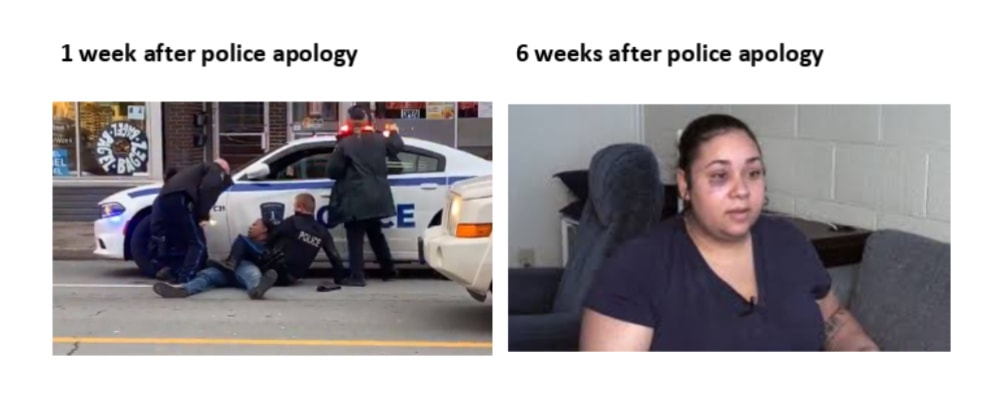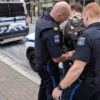
KJIPUKTUK (Halifax) – It happened in Walmart at Halifax’s West End Mall. Santina Rao, a young mother who is Black, picked up a head of lettuce, two lemons and a grapefruit which had to be weighed by the front cashier before she could pay for them. The produce was sitting in her baby carriage, in full view.
With one child riding in the stroller, Rao, and her three-year-old daughter stood in the toy aisle where Rao was planning to buy her daughter a Barbie.
Suddenly six Halifax cops, and three security guards descended on them. The cops pushed Rao to the floor; they broke her wrist, blackened her eye and gave her a concussion.
On Friday, Jan 17, 150 angry people gathered outside Walmart to protest Walmart’s racial profiling of Rao, which resulted in her arrest and her serious injuries.
Others have written about the fascistic nature of the Halifax police attack on Rao. Halifax writer and prisoner rights advocate El Jones has forced the hand of the police chief, who just announced he has “invited” SIRT — the independent police team which investigates all serious incidents — to investigate the behaviour of his police in the Rao case. And Wayne MacKay a retired Dalhousie law professor and human rights expert– not given to overstatement — said “it is still hard to understand why this happened except for the fact of race.”
However, rather than focusing on Rao, in this article, I’m going to write about the Halifax Regional Police, their Code of Ethics, and the Halifax Board of Police Commissioners..
Halifax Police Code of Ethics
Halifax’s Law Enforcement Code of Ethics states that the police have to provide “dignified treatment” to each citizen with whom the police come in contact.
Section 1.2 points out that “each member of the HRP is entitled to his/her own beliefs” but also that police cannot allow “personal feelings to affect their decisions.”
Section 3 exhorts every member of the HRP to “avoid an expression or display of prejudice, bigotry, discrimination and sexual or racial harassment.” It also states that the appearance of bias or prejudice “can be as damaging to the public confidence as would be the actual presence of bias or prejudice.”
Section 4 repeats that “individual dignity is vital to a free system of law” and all should be accorded dignified treatment.
Section 5 says that all HRP members must refrain from conduct or remarks that could put the force in a bad light.
Overall, police policy “prohibits… racially based policing and values the diversity… in HRM”.
In short, seven out of 10 clauses in HRPs Law Enforcement Code of Ethics urge cops not to be racist, and that race or ethnicity should never be used as the “sole” basis for police action. The Code is also very concerned about the image of the Police and putting the whole force in an unflattering light.
But the existence of the Law Enforcement Code of Ethics didn’t stop the Halifax police’s use of street checks. Street checks have been going on for decades. Whether on foot, or in a vehicle, Black Nova Scotians have been routinely stopped, humiliated and even arrested by Halifax police more often than whites.
The first public test of racism and racial profiling in police street checks came more than 17 years ago. African Nova Scotian Kirk Johnson, a professional boxer, complained that the police had stopped him 28 times over a five year period while he was driving his car in Halifax. The Human Rights Commission found in Johnson’s favour, which essentially meant the police lied in giving their evidence at the Human Rights hearing, and at least one high ranking member of the Halifax Police was forced to retire early.
An RCMP study found that in the first 10 months of 2016, 41% of more than 1200 street checks by police in Halifax involved African Nova Scotians.
Another report by the Halifax Police themselves found that between 2005 and 2016, 11% of street checks happened to Blacks, though they made up only 3.59% of Halifax’s population.
University of Toronto professor Scot Wortley’s report found that Black people in Halifax were street checked at a rate six times higher than white people. Halifax Police conducted more street checks than police in Montreal, Ottawa or Vancouver.
Despite the police being aware of all these facts about their own street checks, in April 2019 the acting police chief refused to apologize for them. He claimed an apology would be “disingenuous”.
It took until the release of a legal opinion by Michael MacDonald, former Chief Justice of the Nova Scotia Appeal Court, for Nova Scotia’s Justice Minister to outright ban street checks.And that was in October 2019.
A month later, in November 2019, Halifax’s new police Chief Dan Kinsella (who had been in the job for barely five months), had to apologize for his police force’s years of discriminatory street checks. To a packed crowd at the Central Library’s Paul O’Regan Hall, Kinsella’s apology sounded — well it sounded white and male. Though he acknowledged institutional racism and and racial profiling, he had few ideas about what to do about them.
Kinsella announced there would be anti-racist training for officers, and a community advisory committee (composed of police and Black citizens) to monitor police interactions with Black men, women and youth. He promised, “I, as chief, will take personal responsibility and follow up in every case.”
He went on to say, “On behalf of the Halifax regional police, “I am sorry for our actions that have caused you pain. I am sorry for all of the times you were mistreated, victimized and revictimized.”
However Kinsella’s apology fell flat when he announced his police were going to create a “know your rights campaign” to educate the public about what they can be legally challenged if stopped by cops. To my way of thinking, a “know your rights” campaign places the onus to the person stopped, beaten, or threatened with arrest to challenge the police response. The onus is not on the police to wield less power.
In fact the case of Santina Rao illustrates how misplaced this idea is. Many in the public– and of course the police themselves — have condemned Rao for volubly standing on her rights. There is no way she should have been arrested, handcuffed and carted to jail because she dared to resist the police’s over-the-top reaction to her. She had stolen nothing; she knew her rights and yet she was punished by Halifax Regional Police for challenging them. The police responded by giving her a concussion, a black eye and broke her wrist for challenging them.
Chief Kinsella’s November apology was too little, too threadbare and too late. In light of the Rao incident, the apology was also meaningless in terms of changing the Police’s racist and violent reactions to Blacks.
Surely part of a good apology is to make clear that you are going to change what was done, and move ahead to change the police culture.
Clearly this was not in the cards. While Santina Rao was not technically street checked, the fact she was singled out, assaulted and arrested in the aisle of a store is remarkably similar to police stopping a Black pedestrian. The operating assumption in both cases is that black folks are up to no good. Four big police officers attacked Rao because they could, and they could do it with impunity.
Clearly the police’s Law Enforcement Code of Ethics was out the window.
As most people know, the exercise of authority in policing is based on command and control. Whoever is at the top plans, directs, coordinates and controls the police force. This is the job of Chief Dan Kinsella.
How did Kinsella become Chief?
On what basis was Kinsella selected to be HRP chief? Like most aspects of management, and human resource management in this city, it is shrouded in secrecy. For example, the Halifax Board of Police Commissioners’ Policy and Procedures Manual section 10 alerts us to several attachments. But the “Process for hiring Chief, HRP” is missing from public view.
Truth be told, Haligonians have no idea how Dan Kinsella was selected to be chief, who else applied or the criteria for the selection. We know he worked for the Hamilton, Ont. Police Service for 32 years and finished as its Deputy of Chief of Operations. He was in senior management of the Hamilton Police Service in 2017, when a 16 year-old Indigenous youth, Devon Freeman, left his group home and went missing. Seven months later, Freeman’s body was discovered hanging from a tree metres from the home. Lawyers for his First Nation and the lawyer for Freeman’s grandmother insisted the police force did not treat the boy’s disappearance as a priority, and did not undertake a serious search because he was merely a “runaway.”
In July 2016, a Hamilton couple was returning home to the woman’s apartment after midnight. They saw three white people taunting black children who were playing on the balcony of the same building. The white adults called the kids the “n” word, and one man threatened to “rape your sisters.” When the good Samaritan couple tried to stop the three spouting hate speech, both the man and woman were assaulted. The woman called the Hamilton police to ask for an investigation into the hate speech, only to be told by a woman cop that she had to “lose that attitude” of frustration. The cop also told her that the police “don’t arrest people for saying bad words.” One of the police called one of the three assailants “a crackhead retard.” The police gave the Samaritan couple a pamphlet on how to make a complaint against the police. Again, at the time Kinsella was part of management of the Hamilton Police Service.
Black activist and writer El Jones writes, “Critics of the Hamilton police culture cite issues with racial profiling, poor relationships with marginalized communities, surveillance and criminalization of left-wing activists, and the growth of white nationalist and far right organizing in Hamilton.”
Jones points out that Hamilton has the highest number of hate crimes in Canada. “While the national average of hate crimes in Canada reported per 100,000 people is 4.9, in Hamilton reported hate crimes reached 17.1 incidents per 100,000 people. Hate crimes have risen every year in Hamilton since 2014.”
Jones suggests that, in light of the high number of hate crimes, one could assume that the Hamilton police would be focused on investigating white supremacist groups. Instead, in 2018, the City of Hamilton was busy declaring the anarchy symbol “hate material” similar to the swastika!
Jones cites the case of Matthew Green, who is the first Black city councillor in Hamilton. He was stopped and racially-profiled by Hamilton police. Writes El Jones, “As a councillor, Green consistently challenged the growing police budget in Hamilton. He identifies the priorities we can expect to see from Kinsella if the trends in policing and policing culture in Hamilton are transferred to Halifax.”
She quotes Councillor Green, “What we have seen is the soaring costs of policing, and militarization of policing. We’ve seen the use of increased fear as a tactic for increasing police budgets, so then you have to look at the use of statistics and the way they are presented particular to our community. And I’m concerned about facial recognition technologies which have been shown to misidentify Black people….
“In what culture was Kinsella raised? What culture will he introduce? Will he bring with him the ballooning budgets of policing and buying every paramilitary product under the sun?”
Perhaps we can look to the members of the Halifax Board of Police Commissioners for clues about why they chose Dan Kinsella to be Chief.
Three HRM councillors sit on the Board, including Lindell Smith, Tony Mancini and Lisa Blackburn, the deputy mayor. There are also four community members from diverse backgrounds. All are sworn to confidentiality and secrecy. The Police Board is supposed to be independent of the police, and not involved in its day to day operations. Much of the Board’s work has to do with budget and money. Yet they are supposed to direct the Chief through “approved board policies.”
In mid-December 2019, the Board met in private to receive a “progress update” on the use of police street checks. However the NS Police Act says that Board meetings are open to the public unless they relate to issues such as discipline, personnel, security matters or contract negotiations.
What is next?
Monday’s (Jan. 20) meeting of the Board to discuss the Rao incident was also closed to the public. But before the Board went in camera Black activist and writer El Jones was allowed to speak – and she demanded the police receive no further budget increase until they make positive changes to their interactions with the Black community.
The Board of Police Commissioners “has an oversight role in responding to complaints” having to do with the Chief of Police. But the Board cannot “exercise jurisdiction” relating to complaints about the police, or any specific investigation or case.
The “good news” is that according to the Police Board’s Policy and Procedures Manual, the Board is supposed to “review its mission, vision, guiding principles and strategic plan annually.”
This should give an opportunity for the Police Chief to turn things around in the force. But no one should hold their breath about that.
The Black community and its growing number of allies will not accept the continued violence, arrests and yes — street checks — by the Halifax Police. And, hopefully, the “good burghers” – Halifax’s white residents – will actually support the Black community’s struggle against police tyranny.
Judy Haiven is on the steering committee of Equity Watch, an organization that fights discrimination, bullying and racism in the workplace. Contact her at equitywatchns@gmail.com
With a special thanks to our generous donors who make publication of the Nova Scotia Advocate possible.
Subscribe to the Nova Scotia Advocate weekly digest and never miss an article again. It’s free!



